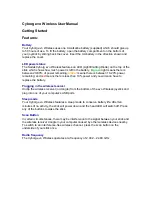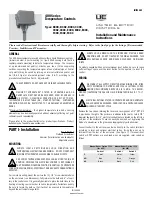
3-17
J Class Technical Reference
Memory System
Average memory latency (E[W]) can be roughly estimated using the ACT (or average service time E[S].)
If Poisson transaction arrivals are assumed, then it may be found using the average issue rate (
) and
average retire rate (
) as follows:
E[W] = E[N] + E[S]
E[N] =
p
1- p
p =
E[S] = 1
< 1 (for a stable queue)
Steady-State Latency
For the purpose of making some comparisons, we will define the term “steady–state” latency. The term
steady–state refers to the condition when both the average issue rate and average retirement rate are
constant, resulting in the average number of queued entries also being constant. Additionally,
steady–state refers to a condition where there is transaction flow balance – the issue rate closely
approximates the retirement rate through the system.
The value of steady–state latency is primarily a function of queue depth and the average cycle time or
service time of the memory system for a given rate of contention. At this point, the latency observed at the
tail of the queue is equal to the Queue depth (E[N]) * Average Cycle (Service) Time (E[S].) For an
average queue depth of 10, and an average cycle (service) time of 10 clocks, one can expect that the
latency for the last, or tail, transaction placed in the queue will be equal to 100 clocks.
The amount of time, or number of transactions required to reach the steady–state is a function of queue
depth and the ratio of the rate transactions are put input the queue verses being extracted from it. While the
average retirement rate is expected to be less than the issue rate (for a stable queue), there are periods of
time when the input rate exceeds that of the output rate, thereby causing transactions to accumulate in the
queue. They accumulate at a rate that is equal to the ratio of (issue/retire) – 1. If the output rate is .2
transaction per clock, and the input rate is 1 transaction every clock, a 5:1 ratio, then 5 – 1 = 4 transactions
will have accumulated in the queue for every transaction retired during that period of time.
Queue length affects system behavior in several ways. First, it determines the rate at which transactions
are issued – for a fixed rate of retirement. Transaction time–variance is also a factor. If the transaction
issue rate is not constant, and therefore time variant, then the queue length affects the rate at which
transactions may be issued. Pulsed or clustered transactions are one example of time variant behavior,
where a high rate of issue exists for short durations of time, but with an average issue rate that is generally
less than the retirement rate. For a given coefficient of variance, the larger the queue, the closer the issue
rate approximates the retirement rate. And, as the coefficient of variance increases, a greater queue length
is required to maintain a given issue rate.
Figure 3–9 plots latency as a function of bank and bus contention for a memory system with a queue
length of 10 entries, which is an average representation of the design. It is used to show that as the number
of banks and busses increase, reducing the Average Cycle Time, the average latency or E[W] per
transaction in the steady–state decreases.
Summary of Contents for Visualize J200
Page 75: ... Figure 6 2 Package Tray Bottom View Figure 6 3 Unpacking Pictorial ...
Page 76: ... 1 1 0 2 1 1 0 2 0 0 3 Figure 6 4 Package Pallet ...
Page 82: ... Figure 8 1 Danish Keyboard ...
Page 83: ... Figure 8 2 French Keyboard ...
Page 84: ... Figure 8 3 German Keyboard ...
Page 85: ... Figure 8 4 Italian Keyboard ...
Page 86: ... Figure 8 5 Japanese Keyboard ...
Page 87: ... Figure 8 6 Korean Keyboard ...
Page 88: ... Figure 8 7 Norwegian Keyboard ...
Page 89: ... Figure 8 8 Spanish Keyboard ...
Page 90: ...8 10 Keyboard Layouts J Class Technical Reference Figure 8 9 Swedish Keyboard ...
Page 91: ... Figure 8 10 Swiss Keyboard ...
Page 92: ...8 12 Keyboard Layouts J Class Technical Reference Figure 8 11 Taiwanese Keyboard ...
Page 93: ...8 13 J Class Technical Reference Keyboard Layouts Figure 8 12 United Kingdom Keyboard ...
Page 94: ...8 14 Keyboard Layouts J Class Technical Reference Figure 8 13 United States Keyboard ...
















































